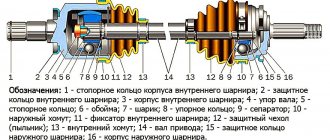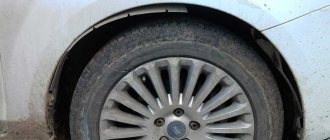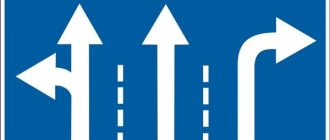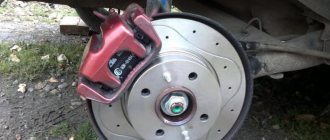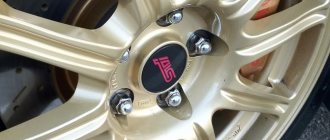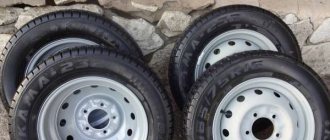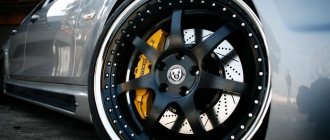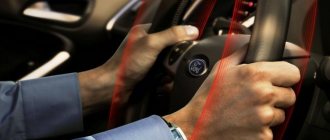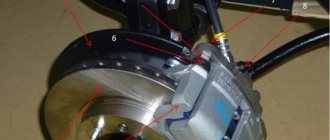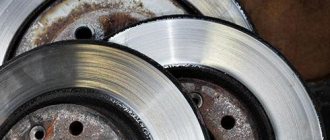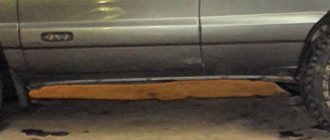The braking system of modern cars consists of a rotating disc and stationary brake pads, which apply pressure to the disc from both sides to slow down the movement. The geometry of the moving element of the brakes must be almost ideal. Otherwise, braking efficiency is significantly reduced.
The curvature of the surface of the brake elements poses a danger to the life and health of motorists, so their condition must be regularly monitored. If functionality is impaired, it must be replaced.
But often service stations that have the appropriate equipment advise a cheaper way out of the situation - regrooving the brake discs. The benefits of workshops are clear, but is it worth the trouble for the driver?
When to change
As a rule, brake discs last for two or three pad changes, but this is ideal. During intensive driving, the wear on the discs can become enormous and there will not be enough for the next pad replacement. Even if you drive in a quiet mode, brake discs are easy to “kill” .
For example, after heavy braking you find yourself in a puddle. Even a special shield under the wheel arch will not save you from water - it only protects from dirt. Because Since most brake discs are made of cast iron, they are subject to sudden temperature changes when water from a puddle cools them sharply. This leads to warping of the working surfaces, which will affect the steering wheel and brake pedal of the car. And it manifests itself when you begin to brake smoothly, and a slight tremor is felt on the steering wheel and brake pedal.
Cast iron is the most common material for brake discs. But with a sharp change in temperature, it changes its hardness, volume and internal structure. There are more durable analogs - ceramic, composite, which provide better stability and braking, but are more expensive.
Risks and acceptable values
Before agreeing to the specialists’ offer, it is important to make sure that such a procedure makes sense at all, since sometimes only replacing them will help:
- If there are cracks or chips in the base, then it is better to throw such elements into a landfill. Otherwise, the brakes may simply fall apart while driving, causing an accident.
- You need to be very careful when making repairs when the disc thickness is minimal, since thin metal will heat up faster.
- After grooving, it is recommended to operate the machine exclusively in a gentle mode.
Despite the limitations described above, workshops with lathes advise turning brake discs for almost any reason.
Before grooving, it is important to determine the thickness of these elements after working with them.
Valid values:
- for products with ventilation they are 0.5-0.6 cm;
- for varieties without ventilation - 0.8-0.9 cm.
Only after preliminary calculations does work on the lathe begin. Such a unit independently rotates the hub, cutting off a thin layer of metal using cutters that move from the center to the periphery. Most often, the part is processed in two or three such passes.
Before starting grooving, the technician must carefully examine not only the condition of the disk itself, but also the wheel bearing. If the latter has a backlash, then there is no point in making a groove. After the procedure, the runout value, the level of corrosion, and the residual thickness of the workpiece are checked. In addition, the old brake pads need to be replaced.
Most often, discs are made of cast iron. This metal changes properties under the influence of sudden temperature changes. Because of this, the working surface warps and its internal structure is damaged.
As a result of processing on the machine, only the top layer is removed, but after several hard braking this element can “lead” again. A damaged disk during processing can only be identified by a very highly qualified specialist.
How to determine when to change brake discs
When replacing pads, you need to carefully inspect the surface of the disc for warping and cracks.
Cracks and other flaws can be easily identified visually. To check warping, you need to run your finger over the surface of the disk - it should be perfectly smooth. If deep waves are noticeable, then we change or sharpen them. If there is slight warping, then urgent replacement is not required. We also pay attention to the residual thickness - it should be at least 50%. After this we decide on a replacement.
There is another way to determine whether brake discs need to be replaced. Typically, beating responds with vibrations on the steering wheel, brake pedal and body. If you feel vibration when braking, then release the brake pedal for a while - if the vibration stops, then you need to change the discs or sharpen them.
Why do they grind discs?
When the discs are deformed, the braking distance increases to 20 meters, so the condition of these elements requires constant attention. It is especially important to do this on modern cars with ABS and PBS systems, since here the safety of the driver and passengers depends on the coordinated actions of all elements of the braking system. This will be entirely determined by the driving skill of the person driving the car on a slippery road.
If the surface of the discs is rough and uneven, then even replacing the brake pads will not give the desired result until they are ground in.
If vibrations occur in the vehicle or the brake pedal, the brake system must be checked immediately.
In case of disc geometry violation, many service stations recommend regrooving. Most manufacturers recommend replacing these elements of the brake system only after 80 thousand kilometers, so repairing these parts can be considered justified.
The moving parts of the brakes are expensive. On the other hand, they have an increased service life compared to static pads. Recently, some car workshops have begun to purchase equipment for turning brake discs. This procedure is much cheaper than a new purchase, so the service is in demand.
Is it worth grinding
If the brake disc of a car has wear in the form of irregularities on the surface, then they can be sharpened. The main thing is to determine the wear so that the thickness allows it to be sharpened. Too thin cannot be sharpened; they will not withstand heat load well, which will result in their destruction. Also, before grooving, they are checked for the degree of corrosion and the amount of runout. The cost of re-grooving is cheaper than the cost of new ones. If the residual depth allows them to be sharpened, then you can save on this operation. It is worth considering that it is necessary to sharpen both brake discs (so as not to shift the balance of the brakes) and then replace the pads with new ones. What is it for? If there was warping, then the friction layer of the pads was also damaged. If you do not change them, they will not fit the entire area. This will reduce the car's braking intensity.
Recommendations after grooving
It is advisable to diagnose the brake system before carrying out the procedure. After grooving, it is advisable to avoid heavy loads on the car. You need to drive the first 50 km without sudden braking. The stop should be smooth. It is advisable not to drive on wet roads. If you have to drive in the rain, it is advisable not to get into deep puddles. You need to drive slowly on wet roads.
If you neglect these recommendations, the disc may become deformed. It may not be possible to restore the parts. The grooving work should be entrusted to qualified service station specialists.
Is it possible to do it yourself?
This is not recommended because...
for example, it is impossible to do this on a lathe - the errors during turning will be large and it will not be possible to fix the disk properly. You may get the effect that it was better before the grooving than after it. Therefore, the auto service center performs this operation without removing it and sharpens both discs at the same time. This is the only way to eliminate different groove thicknesses. It is recommended to do this every time you change the pads.
In the service, the groove will cost about 2 thousand rubles without removing and replacing the pads (not included in the price). For example, the cost of original wheels for a car is 2 times higher. In addition, sharpening factory brake discs is better than buying new ones of unknown quality.
When should it be done?
Every driver is obliged to monitor the condition of the brake discs. It is necessary to check elements for wear every 10-15 thousand kilometers using a caliper. But there is one subtlety in this issue. The fact is that during the operation of a car, brake discs tend to wear down unevenly. Over time, various deformations and grooves may appear on them, which significantly affect the quality of the vehicle braking process. Moreover, the service life of the brake discs may not be exhausted. In such a situation, grooving the elements may be the best option. You can recognize that there are problems with brake discs by the following signs:
- The braking process occurs unevenly and jerkily;
- The appearance of uncharacteristic sounds when braking;
- Beating of the brake pedal or steering wheel when braking;
- When you press the pedal, the brakes lock.
How to find out the abrasion thickness?
In order to find out the permissible maximum thickness of the brake disc, you should look at the end of the product. There are two meanings to this part. This is the original thickness, as well as the minimum allowable. The numbers may vary depending on the car and wheel manufacturer. How to determine the degree of wear of brake discs? It is enough to simply measure with a caliper and compare the numbers with acceptable standards. This is how you determine whether the product can still be used or not. The disc should also be changed if it has different thicknesses at different points.
Grooving brake discs with removal from the car
This grooving method also requires good equipment and accurate measurements in order for the work to be completed efficiently. Unlike the previous method, here it is necessary to completely remove the brake disc from the car and grind three surfaces, including those adjacent to the hub.
It is important that all three surfaces are machined at the same time with one attachment to the machine, otherwise the parallelism of the planes may be lost if the disk is “turned over”. Accordingly, for such work you need a specialized machine or a reverse cutter, otherwise it will be difficult to get close to the third plane.
Grooving brake discs: what is it?
The process of turning car brake discs is the elimination of irregularities on the disc by removing the “extra” layer of metal. Accordingly, when turning, the thickness of the disc decreases, so severely worn versions cannot be turned.
There are two options for grooving brake discs:
- With removal from the car using a special machine;
- Without removal from the car using special tools.
The second option is most often cheaper and takes less time.
Let's consider each of the options separately.
What affects wear?
Each manufacturer prescribes brake disc wear standards. These parameters are obtained based on engine power, vehicle weight and other factors. But it is very difficult to calculate the mileage after which you will need to change the discs. Wear is influenced by various factors that cannot be taken into account.
First of all, it's your driving style. If the car owner prefers to drive more extreme, where sharp accelerations are replaced by equally sharp braking, then the service life of the disc is significantly reduced.
Mechanical factors also affect the service life. The material from which the brake disc is made is important here, as well as the quality of the pads. Often, discs are made from cast iron and its alloys - the material wears out more often than ceramics. The use of low-quality pads (for example, with asbestos) also leads to uneven wear.
Grooving brake discs without removing them from the car
If you do not remove the brake discs from the car, sharpening them is much easier. But the important point here is that you need to have appropriate equipment, which is not present in all services. In other words, it is unlikely that it will be possible to grind brake discs in a similar scenario “in the garage.”
Grinding of brake discs without removal is carried out as follows:
The car must be secured on a lift and the wheels removed;- Next, access to the disk is freed; to do this, you need to unscrew the caliper (hanging it by the holder to the spring);
- After this, using tools, the approximate curvature of the disk blade is measured to determine how much metal needs to be removed from the part;
- Next, a special engine is attached to studs or fastening points. His task will be to promote the disk. A frame is screwed to the support, which will serve for the movement of the cutters. It is important to note that the cutters must simultaneously grind the planes above and below;
- After this, the actual grooving process begins.
Growing brake discs without removing them from the car does not take much time. It is important to note that two planes are machined. The area adjacent to the hub, since the disk is not removed, remains untouched. This is an important difference from the disc removal method.
Wear of the brake disc as a reason for its grooving
Wear on the working surface of the disk occurs for the following reasons:
- During the braking process, close contact occurs between the disc and the pads, and part of the working surface material is simply abraded mechanically.
- Dust, various particles of soil, road surface and other small contaminants get between the disc and pads, act as an abrasive, and increase the wear rate significantly.
- If worn down to the ground, brake pads, if not replaced in a timely manner, turn into a cutting tool and begin to remove disc material.
The wear process occurs uncontrollably and leads to uneven abrasion of the working surface. As a result, irregularities appear on it in the form of grooves, shoulders and waviness, which reduce braking efficiency even after replacing the pads with new ones.
Grooving the disc allows you to eliminate these defects and completely restore its functionality.
How to sharpen a brake disc yourself
Grinding brake discs “in the garage” without the right tools and necessary skills is strictly not recommended. On automobile forums you can find “collective farm” options for grooving - with a grinder, a file, or even with a piece of sandpaper placed on top of the disc. By engaging in such manipulations, you risk making the disc unsuitable for grooving even by masters, and, in addition, such a disc can fail at the most inopportune moment, not to mention the lack of symmetry during “collective farm” grooving.
( 398 votes, average: 4.49 out of 5)
Engine camshaft knocking: causes and troubleshooting
How to adjust the headlights yourself and when do you need to adjust them?
